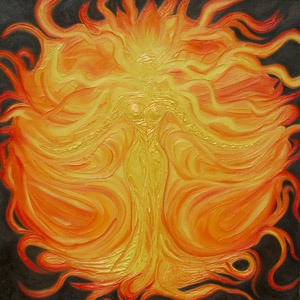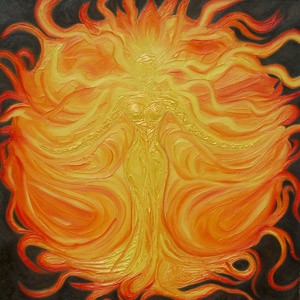
Near the holy door in turf hut
Sun’s daughter — Njávesheatne
Tired of life’s heavy burdens
Yearned to ‘scape, to another place
Wishes to see God, the master
The Thunder God, foe of giants
Wants to see the Sun, her father.
She awaits the spirit of death,
In turf hut near the holy door
The Sun’s daughter — Njávesheatne
She who corralled the wild reindeer
Gave it then to the Sun’s children
On her last journey she shall fare
He stands by her bed, her son,
The evil Áhchesheane’s bane
At the foot of the bed a girl
Young daughter of Áhchesheane
The Sun’s beautiful daughter speaks
She’s hard to hear, weak is her voice
Hear her words, and remember them!
The Sun’s beautiful daughter says:
The Sun’s setting, night is coming
Darkness blankets lovely Sápmi
Morning will come, will it not?
The sun slowly sinks, the wolf comes
Slinks around in the dark of night
Wily it is when it’s hunting,
Morning will come, will it not?
The sun is setting, the herd shrinks,
The pest rages, insects torment,
Children grope about in the dark,
Morning will come, will it not?
The sun slowly sinks. Withdraws its light,
The Sun’s daughter to father goes
Takes with her too the Sun’s children
Morning will come, will it not?
The Death of the Sun’s Daughter
by Anders Fjellner
______________________________________________________
Biejjen nieide (south Sámi), “The Sun’s daughter”, is a long legend which is known in various forms in several Sámi areas of Norway and Sweden.
The good sun-daughter Njavvis-ene lived a long life. When she finally felt that death was near, she ordered that she should be buried at the top of the very highest peak. From there she could see all around and follow what the people were doing.
When she died she was buried with great ceremony on a mountain top which is known today as the “Sun Daughter’s Mountain”. She was wrapped in a shroud and laid on a bed of njavvi, the long hair from the reindeer’s neck, which was also the name of her husband. A stone was set up at the head, another at the feet and one at each arm. A flat slab of rock was placed over the top. This was carefully covered with turf and on the foot stone was inscribed: “The turf raised, read the memorial”. And thus stands the grave to this day on the Sun Daughter’s Mountain.
Sources:
Lundmark, Bo, 1979: Anders Fjellner – Samernas Homeros.




